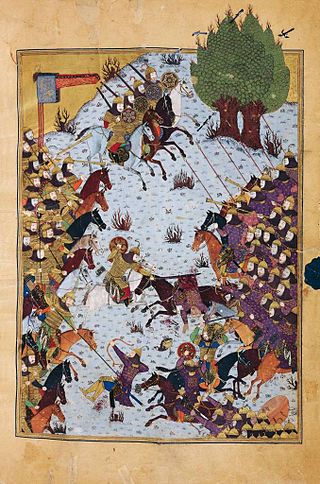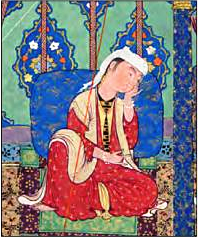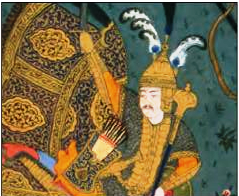Related Research Articles

Khosrow II, commonly known as Khosrow Parviz, is considered to be the last great Sasanian King of Kings (Shahanshah) of Iran, ruling from 590 to 628, with an interruption of one year.

Bahram V, also known as Bahram Gur, was the Sasanian King of Kings (shahanshah) from 420 to 438.

Afrasiyab is the name of the mythical king and hero of Turan. He is the main antagonist of the Persian epic Shahnameh, written by Ferdowsi.

Rostam or Rustam is a legendary hero in Persian mythology, the son of Zāl and Rudaba, whose life and work was immortalized by the 10th-century Persian poet Ferdowsi in the Shahnameh, or Epic of Kings, which contains pre-Islamic Iranian folklore and history. However, the roots of the narrative date much earlier.

Bānbishn was a Middle Persian title meaning "queen", and was held by royal women in Sasanian Iran who were the king's daughters and sisters, and also by the consorts of the Sasanian princes that ruled parts of the country as governors. The full version of the title was bānbishnān bānbishn.

Siyâvash, also spelled Siyâvoš or Siavash (سياووش), is a major figure in the Shahnameh. He is introduced by Ferdowsi as the son of Kay Kāvus, who reigns as Shah in the earliest days of Greater Iran for over a century. His name means "the one with black stallions" after his horse Shabrang Behzād, who accompanies him during a trial of righteousness.

Bijan and Manijeh is a love story in Ferdowsi's Shahnameh. Bijan was the son of Giv, a famous Iranian knight during the reign of Kay Khosrow, the Shah of Iran, and Banu Goshasp, the heroine daughter of Rostam. Bijan falls in love with Manijeh, the daughter of Afrasiab, the king of Turan and the greatest enemy of Iran. The tale of his suffering and Manijeh’s constancy has been quoted by several others.

Kay Khosrow is a legendary king of Iran of Kayanian dynasty and a character in the Persian epic book, Shahnameh. He was the son of the Iranian prince Siavash who married princess Farangis of Turan while in exile. Before Kay Khosrow was born, his father was murdered in Turan by his maternal grandfather Afrasiab. Kay Khosrow was trained as a child in the desert by Piran, the wise vizier of Afrasiab. His paternal grandfather was Kay Kāvus, the legendary Shah of Iran who chose him as his heir when he returned to Iran with his mother. The name Kay Khosrow derives from Avestan 𐬐𐬀𐬎𐬎𐬌 𐬵𐬀𐬊𐬯𐬭𐬀𐬎𐬎𐬀𐬢𐬵𐬀Kauui Haosrauuaŋha, meaning "seer/poet who has good fame".

Farangis or Frigis is a female character in the Persian epic Shahnameh.

Sudabeh or Sodaba is a character in the Persian epic Shahnameh. She was princess of Hamavaran kingdom and later, becomes the wife of Kay Kāvus, King of Iran, and stepmother to prince Siyavash.
Faramarz-nama or Faramarz-nameh is a Persian epic recounting the adventures of the hero Faramarz who is the son of Rustam.
Kush-Nama, is a Persian epic poem and part of a mythical history of Iran written by Ḥakim Iranshān ibn Abu l-Khayr between the years 501-04/1108-11.
Arnavāz is one of the two daughters of Jamshid, the mythological king of Parsia. Arnavāz and her sister, Shahrnāz first married Zahhāk, but later married Fereydun, after he had defeated Zahhāk and imprisoned him in mount Damāvand. In some versions of Shahname, including the Moscow version and that of Ṯaʿālebī, Arnavaz and Shahrnāz are the daughters of Jamshid, but in others, they are his sisters.

Fariburz is an Iranian hero in Shahnameh, the national epic, of Greater Iran.

Zangay-i Shavaran is an Iranian hero at the time of Kay Khosrow. His fame is in relation to Wife Siyavash Jawira. After Siyâvash death, Iranians did not know about Siyavash family in Turan. Only two Iranians knew of Siavash and Jawira marriage, and Zangay-i Shavaran and Bahram were both.

Nastihan is a Turanian hero who was involved in the Iran-Turan wars. He fled from the Battle of Homavn. Afrasiab sent Nastihan to the Iranian war after killing his other son Houman with 10,000 men.
Iran is mentioned in the Shahnameh in the middle of Fereydoun Kingdom as a country or nation. Before the reign of Fereydoun, during the reigns of Zahhak, Jamshid, Tahmuras, and Keyumars the first Iran king, There is no word about Iran. The first of the term Iran is during the marriage of three sons of Fereydoun. In this sense, the name of Iran is from the period of Fereydoun reign.
Ashkash(Persian: اشکَش ) or Askas or Arsakes is a major figure in the Shahnameh. He is introduced by Ferdowsi as the general of Kay Khosrow's army.


